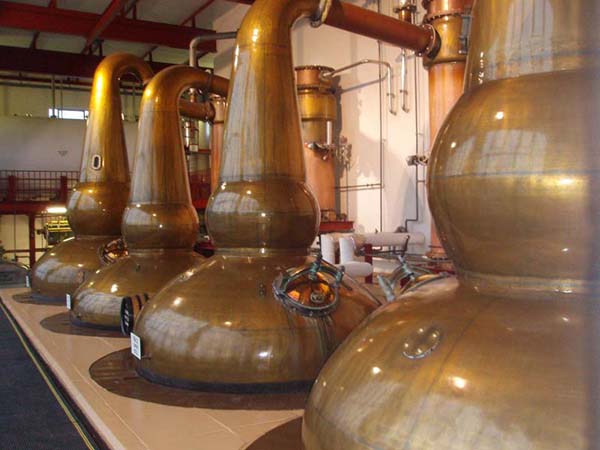In 1823, a more liberal act was passed and within a few years the number of licensed distilleries had grown from a dozen to over three hundred. It should be noted, however, that most of these were located on the edge of the Highlands or in the Lowlands where they were easily accessed. By law, a distiller with stills of over 500 gallons capacity could apply for a licence on payment of £10, but stills with a capacity of under forty gallons were made illegal. To add insult to injury, licensed distilleries were obliged to house a resident exciseman, a debatable asset under any circumstances.
 |
Glendronach Stills |
With the Industrial Revolution came engineering and the railways. Legitimate distilleries, which had for the most part begun as small scale operations, were streamlined but were still largely owned and controlled by the families who had founded them. At the same time, a speculative boom was being created among the Victorian investors of the 1890s – distilleries were showing a good return on capital and, in keeping with this, a large number of new brand names started to appear.
But it was all too good to be true, and within ten years the market became flooded, causing a large number of distilleries to change ownership. Some survived and prospered; others simply disappeared without a trace. Overall, ownership of the Scotch Whisky Industry in Scotland was to change dramatically after 1887, the year in which Alfred Bernard compiled his authoritative and invaluable book The Whisky Distilleries of the United Kingdom.
And there was another factor to contend with. In the second half of the nineteenth century, the production of grain whisky, entirely different from that of malt whisky in its distillation process and taste, was to lead to the revolutionary discovery of blending.
It began around 1827, when Robert Stein, by then the most prominent distiller in Scotland, took out patents for a still which was heated internally by steam, instead of by an external furnace. This apparatus had the advantage of distilling whisky in one continuous operation, unlike the traditional pot-still which had to be filled, emptied and filled again. Stein carried out some trials at his Kirkliston Distillery, at the same time encouraging his cousin John Haig to do likewise at Cameron Bridge Distillery. It changed everything.
But it was Aeneas Coffey, a Dublin-based exciseman, who, in 1830, was shrewd enough to further adapt, patent and market the idea. With 'Coffey's Continuous Patent' stills, it suddenly became possible to produce a light, palatable whisky, both fast and economically.
Up until then the strong consistency of a single malt whisky had been limited in its wider appeal, and in consideration of this, the manufacture of grain spirit from a mixture of barley and other cereals was revolutionary. Dramatically different from malt whisky, not only in its distillation but in its taste, grain whisky nowadays represents on average around 60 per cent of the contents of most bottles of blended whisky.
With the advent of blended whiskies, therefore, an entirely new dimension was added to the product's consumer appeal. Today, there are seven massive grain distilleries operational in Scotland, with 95 per cent of their production going into Scotch blends. Throughout the twentieth century, entrepreneurial Whisky Barons such as Tommy Dewar, James Buchanan and the Walker, Mackie and Teacher families took their brands to far corners of the globe.
However, it was the advent of a “whisky lake” and the re-emergence of single malts during the 1980s, which unexpectedly brought about the greatest escalation in the industry's most recent fortunes.
No longer were Scotland's distilleries allowed to be largely inaccessible to the general public. As the industry increasingly threw open its doors to visitors, no more were the magical malts of Scotland a connoisseur's secret. The pioneers were William Grant Sons with their imaginative facilities at the Glenfiddich Distillery on Speyside, and they were rapidly followed up by a flood of other charismatic brand names. Nowadays, the general public is actively encouraged to visit distilleries throughout Scotland, to experiment and to understand the difference between a blended whisky and a single malt, and to appreciate the regional variations.
























